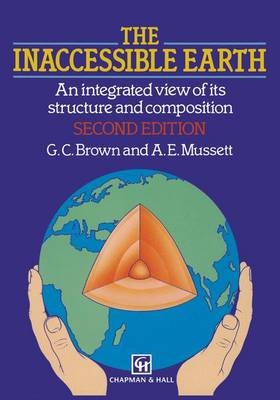
The Inaccessible Earth
Chapman and Hall (Verlag)
978-0-412-48160-4 (ISBN)
- Titel ist leider vergriffen;
keine Neuauflage - Artikel merken
In the dozen years since the first edition appeared, there has been a great advance in understanding of the Earth's deep interior. This is not because there have been breakthroughs in understanding, or even many changes of ideas, but largely because of many small advances, often the result of improved tech- niques. This has led to a complete revision of the book. For instance, we have a much better idea of how the cloud of gas that formed the Solar Nebula evolved into the Sun and the planets, and of the chemical processes that accompanied its evolution and determined the mix of elements in the Earth. We have a better understanding of convection and how plates are an essential part of it, and how it is accompanied by chemical processes that have extracted the materials to build continents. Although the major variation within the Earth is radial, improved geophysical and geochemical techniques have made progress in investigating and under- standing the lateral heterogeneities, and it is encouraging that when geochemists and geophysicists talk about lateral heterogeneities they can sometimes be referring to the same thing.
Plumes have become very fashionable as the cause of hot-spot magmatism and associated geochemical anomalies, probably origi- nating at the base of the mantle (though clear evidence for their existence is lacking).
1 Introduction.- 1.1 Aims and objectives.- 1.2 'The Inaccessible Earth': an outline.- 1.3 History of ideas about the Earth.- Further reading.- 2 The contribution of seismology.- 2.1 Seismic waves.- 2.2 Deduction of P- and S-wave velocities at depth.- 2.3 Seismic velocities and the structure of the Earth.- 2.4 Surface waves.- 2.5 Free oscillations of the Earth.- Summary.- Further reading.- 3 The density within the Earth.- 3.1 Introduction.- 3.2 The mass of the Earth.- 3.3 The moment of inertia of the Earth.- 3.4 The simple self-compression model: the Adams-Williamson equation.- 3.5 Defects of the self-compression model.- 3.6 More sophisticated models and a contemporary result for the Earth's density variation.- Summary.- Further reading.- 4 The formation of the Solar System and the abundances of the elements.- 4.1 Why it is necessary to look outside the Earth.- 4.2 Introducing the Solar System and the Galaxy.- 4.3 Formation of the Solar System.- 4.4 Abundances of the elements.- 4.5 Meteorites and asteroids.- Summary.- Further reading.- 5 The accretion and layering of the terrestrial planets.- 5.1 The first 100 million years.- 5.2 Pre-planetary chemical processes.- 5.3 Post-accretional chemical processes.- 5.4 The Earth-Moon system: a special relationship.- 5.5 Mars, Venus and Mercury: a postscript.- Summary.- Further reading.- 6 The Earth's core.- 6.1 Problems posed by the core.- 6.2 The Earth's magnetic field and the problem of energy.- 6.3 Energy sources for the dynamo: (a) thermal convection.- 6.4 Compositions of the inner and outer cores.- 6.5 Energy sources for the dynamo: (b) compositional convection.- 6.6 Temperature in the core.- Summary.- Further reading.- 7 The mantle and oceanic crust.- 7.1 Introduction.- 7.2 The upper mantle: mineralogical and chemical relationships.- 7.3 Experimental petrology and the upper mantle.- 7.4 Structure and evolution of spreading ridges.- 7.5 The transition zone.- 7.6 The lower mantle.- Summary.- Further reading.- 8 The dynamic mantle.- 8.1 Introduction.- 8.2 Rheology of the mantle.- 8.3 The thermal balance sheet: heat sources and sinks.- 8.4 Convection in the mantle.- 8.5 Temperature within the mantle.- 8.6 The Earth as a heat engine.- Summary.- Further reading.- 9 Evolution of the mantle.- 9.1 Introduction.- 9.2 Does convection cross the 660-km discontinuity?.- 9.3 Geochemical heterogeneity in the mantle.- 9.4 Synthesis.- Summary.- Further reading.- 10 The continental crust.- 10.1 The nature of the Earth's continental crust.- 10.2 Crustal structure, composition and rheology.- 10.3 Processes in zones of lithospheric convergence.- 10.4 Processes in zones of lithospheric extension.- Summary.- Further reading.- 11 Evolution of the Earth's continental crust.- 11.1 The framework of crustal evolution.- 11.2 Archaean and pre-Archaean Earth history.- 11.3 The Proterozoic.- 11.4 The Phanerozoic.- 11.5 Isotopes and crustal evolution.- 11.6 A history of the Earth and a final summary.- Further reading.- Postscript: the new state of ignorance.- Notes.- 1 Moment of inertia, angular momentum, etc..- 3 Electromagnetic stiffening, and heating.- 4 Radiometric dating.- 5 The atom and the nucleus.- 6 Electronegativity and the electronic structure of atoms.- 7 Earthquake fault-plane solutions.- 8 Gravity and the geoid.- References.
| Zusatzinfo | 121 black & white illustrations, biography |
|---|---|
| Verlagsort | London |
| Sprache | englisch |
| Maße | 189 x 246 mm |
| Gewicht | 500 g |
| Themenwelt | Naturwissenschaften ► Geowissenschaften ► Geologie |
| ISBN-10 | 0-412-48160-X / 041248160X |
| ISBN-13 | 978-0-412-48160-4 / 9780412481604 |
| Zustand | Neuware |
| Informationen gemäß Produktsicherheitsverordnung (GPSR) | |
| Haben Sie eine Frage zum Produkt? |
aus dem Bereich


